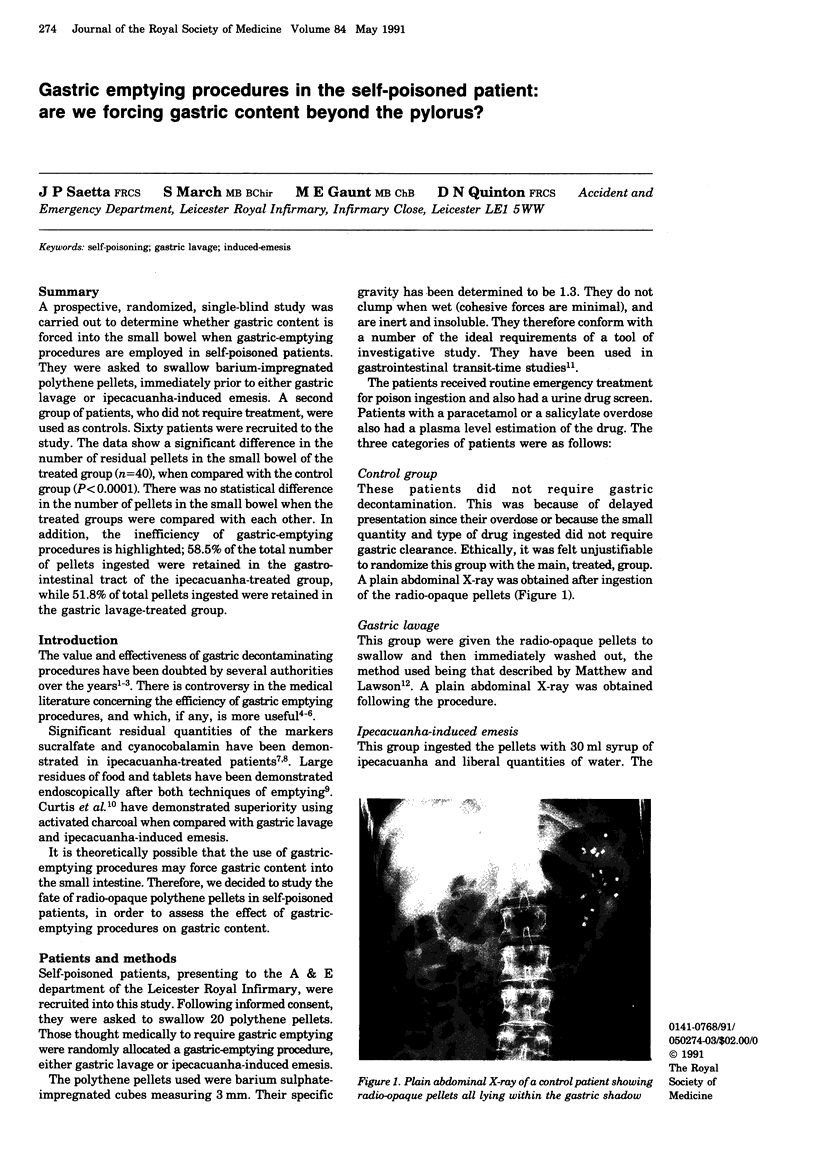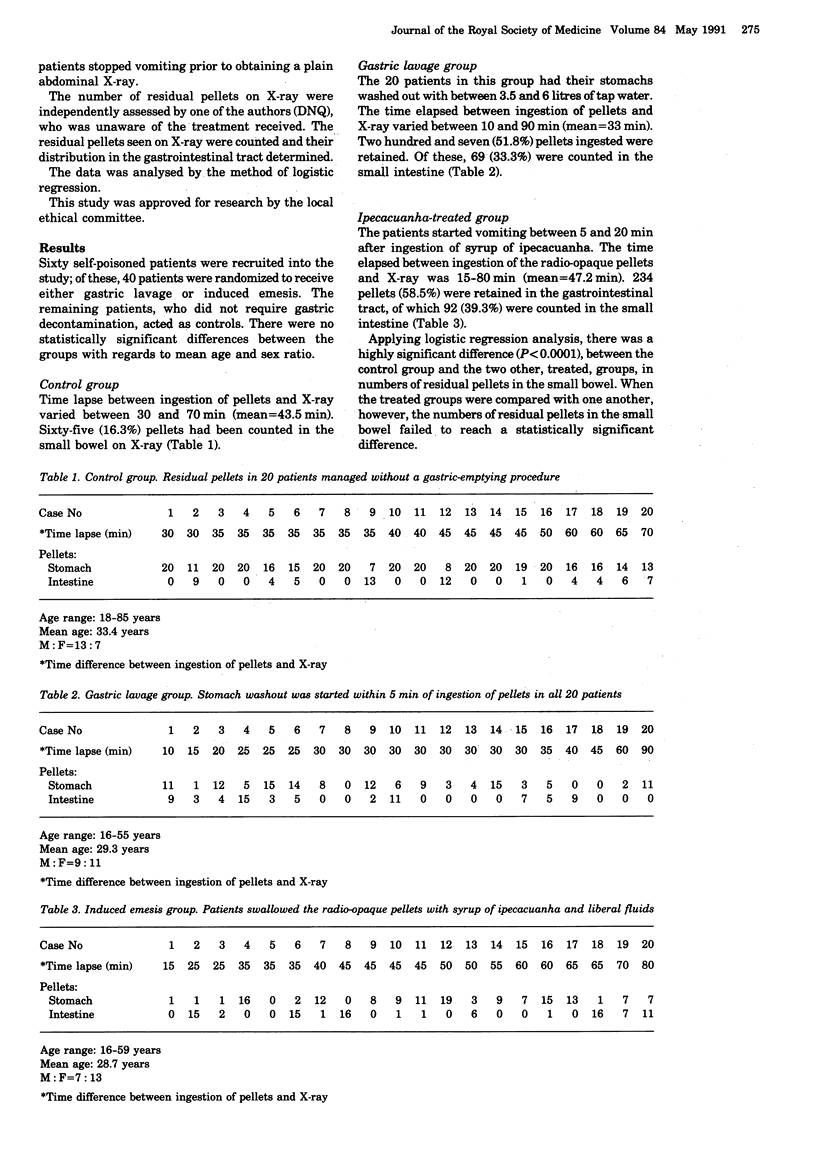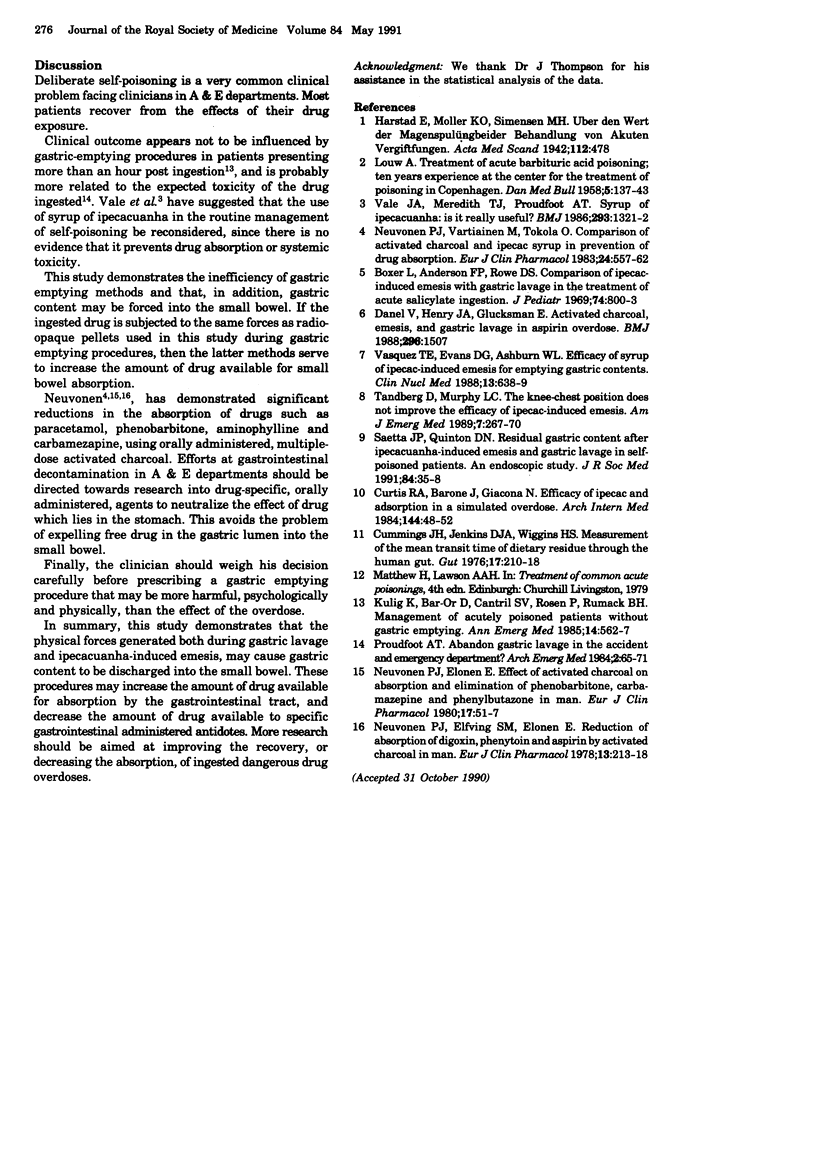Abstract
A prospective, randomized, single-blind study was carried out to determine whether gastric content is forced into the small bowel when gastric-emptying procedures are employed in self-poisoned patients. They were asked to swallow barium-impregnated polythene pellets, immediately prior to either gastric lavage or ipecacuanha-induced emesis. A second group of patients, who did not require treatment, were used as controls. Sixty patients were recruited to the study. The data show a significant difference in the number of residual pellets in the small bowel of the treated group (n = 40), when compared with the control group (P less than 0.0001). There was no statistical difference in the number of pellets in the small bowel when the treated groups were compared with each other. In addition, the inefficiency of gastric-emptying procedures is highlighted; 58.5% of the total number of pellets ingested were retained in the gastrointestinal tract of the ipecacuanha-treated group, while 51.8% of total pellets ingested were retained in the gastric lavage-treated group.
Full text
PDF


Images in this article
Selected References
These references are in PubMed. This may not be the complete list of references from this article.
- Boxer L., Anderson F. P., Rowe D. S. Comparison of ipecac-induced emesis with gastric lavage in the treatment of acute salicylate ingestion. J Pediatr. 1969 May;74(5):800–803. doi: 10.1016/s0022-3476(69)80147-2. [DOI] [PubMed] [Google Scholar]
- Cummings J. H., Jenkins D. J., Wiggins H. S. Measurement of the mean transit time of dietary residue through the human gut. Gut. 1976 Mar;17(3):210–218. doi: 10.1136/gut.17.3.210. [DOI] [PMC free article] [PubMed] [Google Scholar]
- Curtis R. A., Barone J., Giacona N. Efficacy of ipecac and activated charcoal/cathartic. Prevention of salicylate absorption in a simulated overdose. Arch Intern Med. 1984 Jan;144(1):48–52. [PubMed] [Google Scholar]
- Danel V., Henry J. A., Glucksman E. Activated charcoal, emesis, and gastric lavage in aspirin overdose. Br Med J (Clin Res Ed) 1988 May 28;296(6635):1507–1507. doi: 10.1136/bmj.296.6635.1507. [DOI] [PMC free article] [PubMed] [Google Scholar]
- Kulig K., Bar-Or D., Cantrill S. V., Rosen P., Rumack B. H. Management of acutely poisoned patients without gastric emptying. Ann Emerg Med. 1985 Jun;14(6):562–567. doi: 10.1016/s0196-0644(85)80780-0. [DOI] [PubMed] [Google Scholar]
- LOUW A. Treatment of acute barbituric acid poisoning; ten years' experience at the centre for the treatment of poisoning in Copenhagen. Dan Med Bull. 1958 May;5(4):137–143. [PubMed] [Google Scholar]
- Neuvonen P. J., Elfving S. M., Elonen E. Reduction of absorption of digoxin, phenytoin and aspirin by activated charcoal in man. Eur J Clin Pharmacol. 1978 May 31;13(3):213–218. doi: 10.1007/BF00609985. [DOI] [PubMed] [Google Scholar]
- Neuvonen P. J., Elonen E. Effect of activated charcoal on absorption and elimination of phenobarbitone, carbamazepine and phenylbutazone in man. Eur J Clin Pharmacol. 1980 Jan;17(1):51–57. doi: 10.1007/BF00561677. [DOI] [PubMed] [Google Scholar]
- Neuvonen P. J., Vartiainen M., Tokola O. Comparison of activated charcoal and ipecac syrup in prevention of drug absorption. Eur J Clin Pharmacol. 1983;24(4):557–562. doi: 10.1007/BF00609903. [DOI] [PubMed] [Google Scholar]
- Proudfoot A. T. Abandon gastric lavage in the accident and emergency department? Arch Emerg Med. 1984 Jun;1(2):65–71. doi: 10.1136/emj.1.2.65. [DOI] [PMC free article] [PubMed] [Google Scholar]
- Saetta J. P., Quinton D. N. Residual gastric content after gastric lavage and ipecacuanha-induced emesis in self-poisoned patients: an endoscopic study. J R Soc Med. 1991 Jan;84(1):35–38. doi: 10.1177/014107689108400113. [DOI] [PMC free article] [PubMed] [Google Scholar]
- Tandberg D., Murphy L. C. The knee-chest position does not improve the efficacy of ipecac-induced emesis. Am J Emerg Med. 1989 May;7(3):267–270. doi: 10.1016/0735-6757(89)90167-8. [DOI] [PubMed] [Google Scholar]
- Vale J. A., Meredith T. J., Proudfoot A. T. Syrup of ipecacuanha: is it really useful? Br Med J (Clin Res Ed) 1986 Nov 22;293(6558):1321–1322. doi: 10.1136/bmj.293.6558.1321. [DOI] [PMC free article] [PubMed] [Google Scholar]
- Vasquez T. E., Evans D. G., Ashburn W. L. Efficacy of syrup of ipecac-induced emesis for emptying gastric contents. Clin Nucl Med. 1988 Sep;13(9):638–639. doi: 10.1097/00003072-198809000-00004. [DOI] [PubMed] [Google Scholar]



